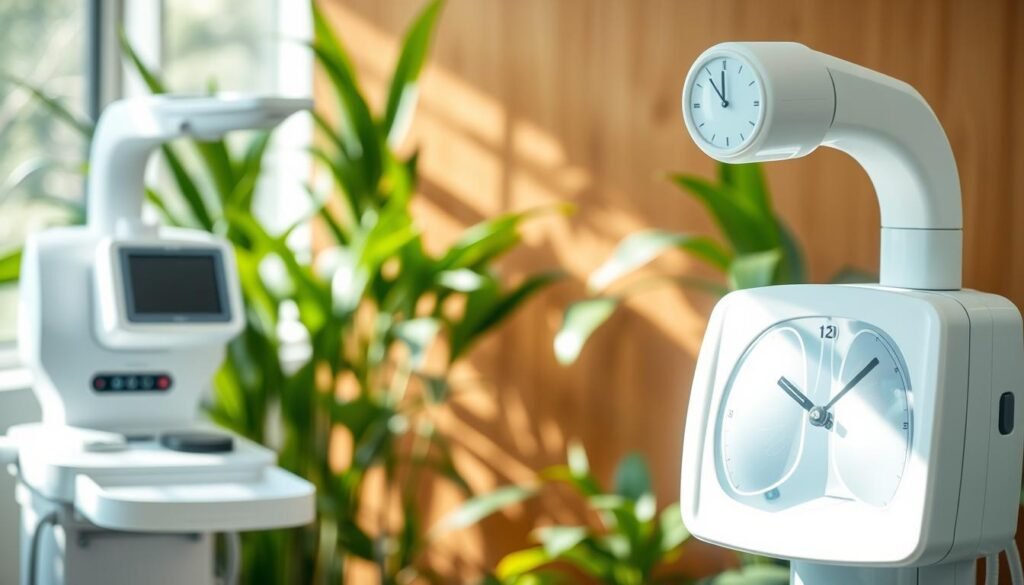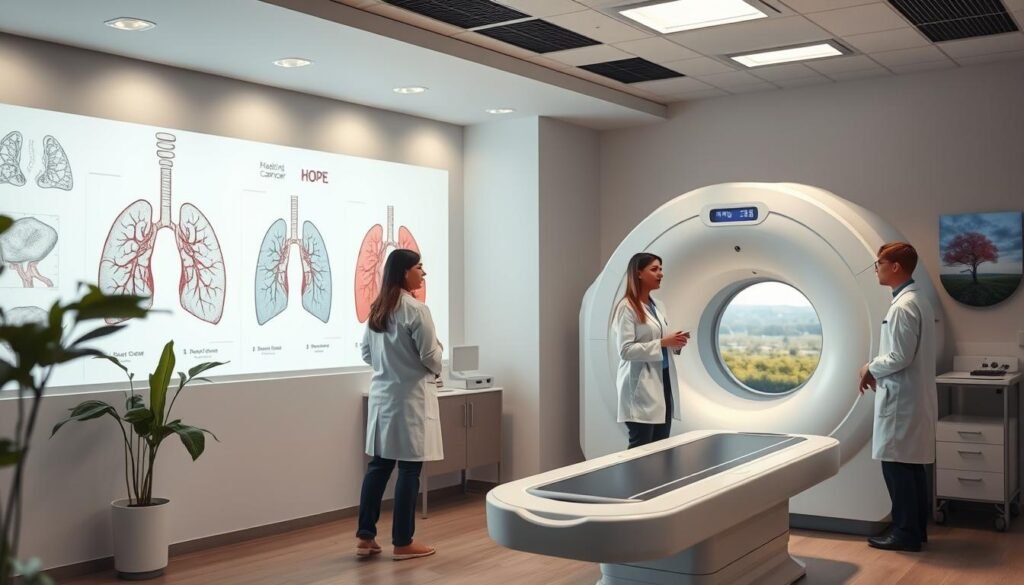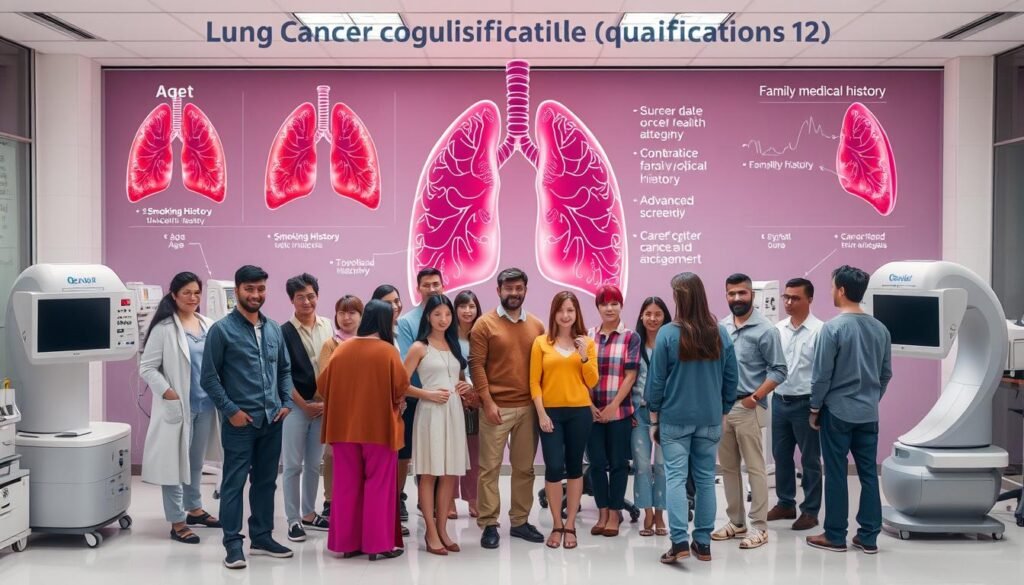Did you know that nearly 5 million more people in the United States will become eligible for lung cancer screening each year thanks to updated guidelines? This significant increase sheds light on why it’s crucial to understand lung cancer screening criteria. Early detection can greatly enhance treatment outcomes and survival rates.
The American Cancer Society and the U.S. Preventive Services Task Force (USPSTF) give important guidelines. These guidelines help people figure out if they qualify for screening. This is based on important factors like age and smoking history. Knowing these factors can lead to early interventions. This helps manage health risks linked to lung cancer better.
Key Takeaways
- Updated guidelines expand eligibility for lung cancer screening to an additional 5 million individuals annually.
- Yearly screening is recommended for those aged 50 to 80 who currently smoke or have smoked in the past.
- A 20+ pack-year smoking history qualifies individuals for screening, lowering the previous requirement of 30+ pack-years.
- Timely screening can lead to improved treatment success through early detection.
- A multi-faceted approach in workplaces ensures higher screening rates, focusing on risk assessment and follow-up.
Understanding Lung Cancer Screening
Lung cancer screening is about finding cancer early in high-risk people without symptoms. It mainly uses a method called low-dose computed tomography or LDCT. LDCT works better than old X-rays, raising the odds of catching cancer early.
The American Cancer Society recommends yearly LDCT scans for certain adults. This includes those 50 and older who smoked a lot over the years. It also suggests screening for former heavy smokers who quit in the past 15 years.
Age and smoking history matter, but overall health does too in screening for lung cancer. People in good health with strong lungs are usually good candidates. But, if someone has serious health issues or is very frail, screening might not help.
Lung cancer is the top cause of cancer deaths worldwide. Fortunately, screening, especially with LDCT, has helped find many lung cancers early. Catching it early can lead to better treatment options and chances of survival.
| Aspect | Details |
|---|---|
| Recommended Age | 50 years and older |
| Smoking History | 20 pack years or longer |
| Health Requirements | Generally good health; no severe lung issues |
| Benefits of LDCT | Higher sensitivity; reduced radiation exposure |
| False Positive Rate | Approximately 7-8% |
| False Negative Rate | About 6-7% |
Knowing about lung cancer screening helps people make wise choices for their health. It’s all about using the right methods to stay ahead of the disease.
Importance of Early Detection
Finding lung cancer early is key to improving cancer survival rates and lung cancer prognosis. In the U.S., lung cancer is the top cause of cancer deaths. This shows how critical it is to diagnose it early. Sadly, only 21% of lung cancers get found when the tumor is still small (stage I).
Early-stage lung cancer means a much better chance of living five more years after being found. The U.S. Preventive Services Task Force suggests yearly checks for those 50 to 80 who smoked a lot. This helps find lung cancer early, which can save lives.
The Centers for Medicare & Medicaid Services push for these yearly checks too. They catch lung cancer when it’s just starting. But, few people who can get checked actually do. We need more people to know about and use lung cancer screening.
Lung Cancer Screening Eligibility Criteria
When figuring out who should get screened for lung cancer, we look at age, how much a person has smoked, and their health. Figuring out these criteria is key to finding people who need early screening the most.
Age Requirements
The American Cancer Society says people between 50 and 80 should get screened if they meet certain criteria. Age matters a lot when it comes to the risk of getting lung cancer. Studies show that screening starting at 50 can greatly lower lung cancer deaths.
Smoking History
Your smoking history is also super important for screening. If you’ve smoked a pack a day for 20 years, you should think about screening. Even people who quit in the last 15 years could be eligible. This info helps doctors figure out your risk.
Health Considerations
Health issues are also crucial in deciding if you should be screened. If you have health problems that could shorten your life, screening might not be right for you. Also, be ready for treatment if they find lung cancer. A detailed look at your health ensures the right people get screened.
Who Should Get Lung Cancer Screening?
Lung cancer screening is mainly for people in high-risk populations. It’s about finding the right people for screening. These are usually:
- Adults aged 50 to 80 years.
- Current smokers or those who quit in the last 15 years.
- People who have smoked for 20 pack-years. This means smoking a pack a day for 20 years or two packs a day for 10 years.
Doctors say getting a low-dose CT scan every year can lower the chance of dying from lung cancer. These tests can find lung cancer early. That’s before any serious signs like a constant cough or losing weight without trying show up. For people at high risk, finding cancer early can really help them get better treatment.
Remember, lung cancer screening isn’t for everyone. It’s not for those with serious health issues that affect their life expectancy. Teaching high-risk folks about screening’s benefits is key. It helps them see how it might help them.
Lung Cancer Screening Guidelines
Lung cancer screening guidelines are vital for spotting those at risk. The American Cancer Society and the U.S. Preventive Services Task Force have set these rules. They say people aged 50 to 77 who are at high risk should get yearly scans. This low-dose scan helps find cancer early, making treatment more effective.
Doctors should talk about the benefits and limitations of screening. It’s key to know the risks, like small radiation doses and false alarms. The guidelines highlight looking at smoking history, overall health, and if lung cancer runs in the family.
Medicare Part B covers one LDCT scan a year for those who qualify. You must have a history of 20 pack-years of smoking or have quit in the past 15 years. This support follows the American Cancer Society and the U.S. Preventive Services Task Force’s advice.
| Guideline Source | Key Recommendations | Age Range |
|---|---|---|
| American Cancer Society | Annual LDCT for high-risk individuals | 50-77 years |
| U.S. Preventive Services Task Force | Annual screening for those with a significant smoking history | 50-77 years |
Keeping up with lung cancer screening guidelines is important for everyone. Patients and doctors need to review these guidelines often. They change as new research comes out and treatments improve.
Lung Cancer Screening Age Criteria
It’s vital to know who should get screened for lung cancer. Health experts have set age criteria for this. These rules help find people who might benefit from catching cancer early.
Age Range for Screening
People aged 50 to 80 should consider lung cancer screening. This eligible age range is based on research. It shows these people, especially long-term smokers, have a higher cancer risk. Smokers or those who quit in the last 15 years should get yearly scans. This can greatly lower death rates from lung cancer.
Yet, many at-risk people don’t get screened. Knowing and following the rules can lead to early detection and save lives. These age rules help ensure high-risk people get screened.

Doctors should talk with patients about screening’s pros and cons. This chat helps patients make informed choices. Following age guidelines helps catch cancer early. This improves the chances of successful treatment.
Lung Cancer Screening Risk Factors
It’s crucial to know who should get lung cancer screening. The main factor is smoking. If you smoke or have a lot, you’re more at risk. Doctors look at smoking first when deciding who needs screening.
The Role of Smoking
Most lung cancers are because of smoking. If you’re around tobacco a lot, your risk goes up. People 50-80 years old with a 20 pack-year smoking history need screening. The CDC resource has all the info you need.
Other Environmental Factors
But, it’s not just smoking. Air pollution and chemicals can also increase your risk. So can past lung diseases and if cancer runs in your family. Knowing these risks helps see if you need screening. It helps doctors find those who need help the most.
Lung Cancer Screening Recommendations
Lung cancer screening is key for people at high risk. It’s advised yearly for current or recent smokers who are 50 to 80 years old. They should also have smoked for 20 years or more. Finding cancer early can greatly improve treatment success.
Early detection of lung cancer is vital. It helps find cancer when treatment works best. Sadly, many cases are found too late, lowering survival chances. When caught early, 60% of people survive five years. This drops to 33% and 6% for more advanced cancer.
Doctors must share the benefits of screening with patients. This includes lowering the risk of dying from lung cancer. Making decisions together means patients know what to expect. This helps them follow the screening advice.

| Screening Criteria | Age Range | Smoking History | Health Considerations |
|---|---|---|---|
| Annual Screening | 50 to 80 years | 20 pack-years or more | No major health conditions limiting life expectancy |
| End Screening | 81 years and older | Quit for 15 years or more | Ability to undergo lung surgery if needed |
Using these guidelines improves health for at-risk groups. Acceptance and education about screening are crucial. Healthcare providers play a key role in this effort.
Lung Cancer Screening Insurance Coverage
It’s vital to know about lung cancer screening insurance coverage if you’re thinking about this important preventive step. Many insurance policies, including those from jobs, often pay for low-dose computed tomography (LDCT) scans. These scans are for people who meet certain requirements.
Usually, to be eligible, you must be 50 to 80 years old and have a 20 pack-year history of smoking. This counts for both current smokers and those who quit in the last 15 years. For example, Medicare covers people 50 to 77 years old who have a similar smoking history.
Here’s a summary of what different insurances offer:
| Insurance Type | Eligibility Criteria | Coverage Details |
|---|---|---|
| Employer-Sponsored Plans | Aged 50-80, 20 pack-year smoking history | Generally covers LDCT without out-of-pocket costs |
| Medicare | Aged 50-77, 20 pack-year smoking history | Covers annual screening if no signs of lung cancer |
| Marketplace Plans | Aged 50-80, 20 pack-year smoking history | Varies; coverage options may differ widely |
| Medicaid | Eligibility varies by state | Contact local Medicaid for specific coverage information |
| Private Insurance Plans | Often follows employer-sponsored plan criteria | Coverage may not be mandated; contact for details |
For some people, finding financial assistance is crucial for getting lung cancer screenings. There are many programs and resources out there to help with the costs of screening. These costs might not be fully covered by all plans. Talking directly to your insurance company can clear up any questions about coverage, co-pays, or eligibility.
Lung Cancer Screening Qualifications
Knowing who qualifies for lung cancer screening is key for those at risk. The American Cancer Society sets clear guidelines. They define who should get yearly low-dose CT scans. These rules focus on current versus former smokers. This helps people understand if their smoking history makes them eligible.
Criteria for Current Smokers
If you smoke now, you may be eligible for screening if you’re 50 to 80 years old. You also need a 20 pack-year smoking history. This means smoking a pack a day for 20 years. You should discuss quitting smoking and get screened regularly. Doing this can lower the chances of dying from lung cancer, the top cause of cancer deaths in the U.S.
Criteria for Former Smokers
If you quit smoking within the last 15 years, you might still qualify for screening. You must meet the same age and pack-year rules as current smokers. These smoking history guidelines encourage those who’ve quit to care for their lung health. Knowing the risks and benefits of screening could encourage more people to get checked. This can lead to better health choices.
For more info on who can get lung cancer screenings, check out lung cancer screening guidelines.

Lung Cancer Screening Eligibility Quiz
An interactive quiz can quickly check your risk for lung cancer. It lets you consider key points like your age, how much you’ve smoked, and your health. These factors are important to know if you’re eligible for screening.
By answering simple questions, you can understand if you’re a candidate for lung cancer screening. This process helps start conversations with doctors about screening options. Talking about your health early can lead to quicker detection and better results.
Tools like this quiz help you take control of your health journey. They provide valuable info to discuss lung cancer concerns with your doctor. It’s a way to navigate healthcare more confidently.
| Question | Considerations |
|---|---|
| What is your age? | Individuals aged between 50 and 80 years may qualify for screening. |
| Do you currently smoke or have you quit smoking within the last 15 years? | Current smokers or former smokers with recent history are eligible. |
| What is your smoking history (pack-years)? | A minimum of 20 pack-years is required for eligibility consideration. |
| Do you have any concerning symptoms? | Asymptomatic individuals may qualify for screening, but symptoms should be discussed. |
Conclusion
Understanding lung cancer screening is key. It’s especially important for those at risk and their doctors. The criteria show us how early detection can save lives. People who smoke or have smoked need to pay attention.
This is based on results from the National Lung Screening Trial. It shows that early screening can lower lung cancer deaths. It’s a big chance to fight back against this illness.
Talking about screening options is important. It helps at-risk people make good choices for their lung health. Lung cancer is still the top cancer killer in the US.
Yet, early screening can make treatments work better. Right now, not enough people are getting screened. We need to spread the word to change this.
By valuing lung cancer screening, we can save more lives. If you might be at risk, talk to your doctor about getting screened. It’s a crucial step in battling lung cancer.